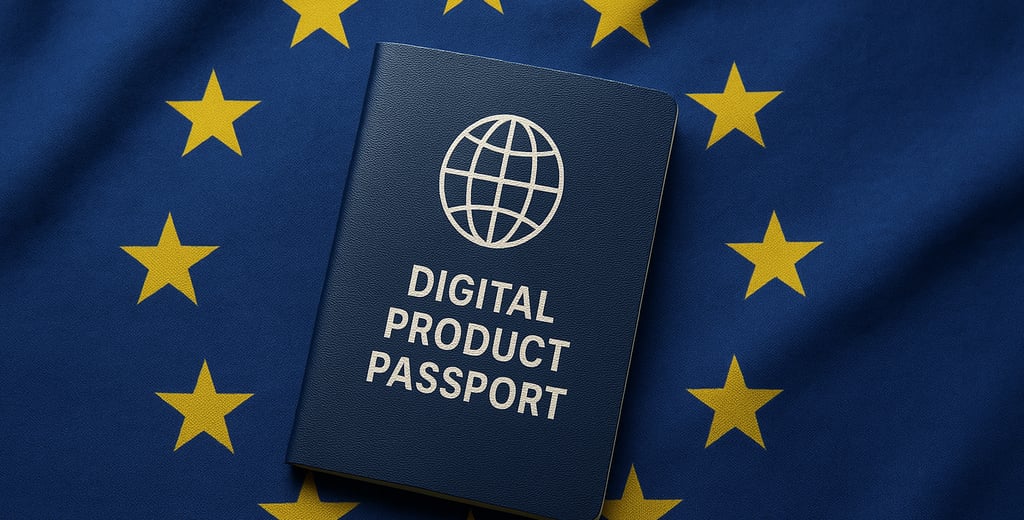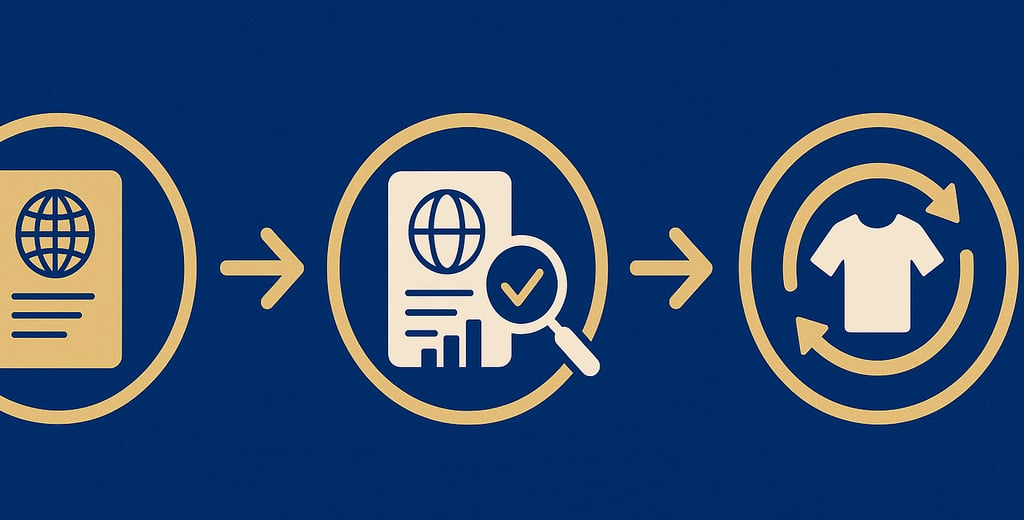✉︎ info@preserveearth.co.uk or WhatsApp Us

EU Digital Product Passport for Textiles: Timelines, Requirements and Implications for UK Businesses
Marketing Team
10/1/202510 min read


The Digital Product Passport (DPP) is one of the flagship initiatives under the European Union’s Ecodesign for Sustainable Products Regulation (ESPR). When the ESPR entered into force on 18 July 2024, it laid the legal foundation for an unprecedented level of supply‑chain transparency across a broad range of products. The DPP concept is simple: each regulated item sold in the EU must have a digital twin that captures detailed information about its origin, material composition, sustainability profile and end‑of‑life options. A unique identifier (QR code, RFID tag or similar) links this digital record to the physical product so that consumers, businesses and regulators can scan and read it instantly. While the idea is straightforward, its implementation will fundamentally reshape how textiles are designed, manufactured and recycled.
In this long‑form guide we examine what the digital passport means for the textile and fashion industries, how it links with Europe’s wider circular‑economy agenda, the evolving UK policy landscape and what businesses should do now. The article draws on the latest European Parliament studies, EU work plans, industry analyses and government documents to provide an up‑to‑date overview for 2025.
What is the Digital Product Passport?
The DPP is not just another sustainability label; it is a machine‑readable, dynamic record of a product’s lifecycle. An EU Parliament study on textiles describes it as “a digital twin containing information on its lifecycle and environmental impact” . The passport must include data such as:
Unique product identification – global trade item number (GTIN), batch or serial number and importer/manufacturer details.
Origin and material composition – country of origin, fibres used, presence of hazardous substances and the percentage of recycled content.
Environmental performance – carbon footprint, energy use, water consumption and environmental product declarations.
Durability and repairability – expected lifespan, care instructions, spare‑part availability and disassembly guidance.
End‑of‑life management – instructions for recycling, guidance on safe disposal and information on material recovery.
Compliance and certification data – proof of conformity with EU legislation and relevant third‑party certifications.
Information will be stored in a decentralised manner, often using GS1 digital links and JSON‑LD schema so that it can be read across platforms. The passport will have public sections (for consumers) and restricted parts accessible only to authorised users (e.g., recyclers or regulators) . From a user’s perspective, scanning the QR code on a garment will open a web page or app showing a ‘product ID card’ with origin, environmental footprint and repair options. Retailers can verify authenticity, regulators can check compliance and recyclers can view fibre composition to optimise recycling.
The DPP is contained in Regulation (EU) 2024/1781 on Ecodesign for Sustainable Products, which came into force on 18 July 2024. The ESPR is a broad framework that sets out general ecodesign requirements for products, but it delegates the technical details to “delegated acts” for each product category. The European Commission’s 2025–2030 working plan identifies the priority sectors and the order in which the delegated acts will be adopted. According to this work plan:
Iron & steel will be covered first, with rules expected in 2026 ;
Textiles, apparel, tyres and aluminium will follow, with delegated acts being finalised in 2027 ;
Furniture will be addressed in 2028 ;
Mattresses and electronics are scheduled for 2029.
The working plan emphasises a phased roll‑out. A general EU guideline expects a central registry for passports to be operational by July 2026 and the first mandatory passports to start with batteries in 2027. For textiles and other high‑impact sectors, requirements will take effect between 2027 and 2030 . Because the ESPR only sets the framework, the exact data fields and technical formats will be defined in each delegated act; however, many sources agree that companies will have roughly 18 months to comply once the act is adopted.
Legislative background: the Ecodesign Regulation and complementary laws
The DPP is one piece of a larger circular‑economy puzzle. Key associated legislation includes:
EU Waste Framework Directive (WFD) – requires separate collection of textile waste from 1 January 2025 and introduces an extended producer responsibility (EPR) scheme for textiles. Member States will have 20 months to transpose the EPR directive and 30 months to implement national schemes. EPR fees may be modulated based on durability, repairability and recyclability – the same information captured in the passport.
Battery Regulation (EU 2023/1542) – introduces a battery passport for industrial and EV batteries starting in February 2027.
Critical Raw Materials Act (CRMA) – requires a passport for products containing permanent magnets with obligations starting in 2027 and 2029.
Green Deal & Circular Economy Action Plan (CEAP) – overarching strategies that aim to make the EU climate‑neutral by 2050. DPPs support the goals of CEAP by enabling repair, reuse and recycling, and they complement new disclosure directives such as the Corporate Sustainability Reporting Directive (CSRD) and the Corporate Sustainability Due Diligence Directive (CSDDD).
Links with other EU laws


Phases of the digital passport
A 2024 European Parliament study proposes a three‑phase deployment for the textile passport:
Minimal & simplified DPP by 2027 – includes essential information such as recycled material content, hazardous substances, recyclability, traceability and packaging details.
Advanced DPP by 2030 – expands data fields to cover deeper supply‑chain traceability, social‑compliance information and detailed lifecycle assessments.
Full circular DPP by 2033 – integrates real‑time data, item‑level tracking and cross‑industry interoperability, enabling fully circular business models.
Delegated act timing and compliance window
The delegated act for textiles is anticipated late 2026 or early 2027, based on the ESPR timeline and industry sources. Once adopted, brands will have around 18 months to meet the new requirements. This means that apparel and footwear companies should expect mandatory digital passports to apply from 2027–2028 . The EU’s working plan calls for more advanced requirements in 2030 and full circular passports by 2033.
EU Parliament and working plan updates
Recent commentary reinforces this timeline. The National Retail Federation notes that textiles are in the first wave of DPP requirements under ESPR and that the delegated acts for textiles will be finalised in 2027, with enforcement 12–18 months later. A 2025 Viamedici analysis explains that ESPR is phasing in DPP adoption by sector: textiles and apparel and tyres from 2027; furniture from 2028; mattresses and other categories later. A guide by Trimco Group likewise expects detailed requirements for textile and footwear passports to be finalised at the end of 2026/beginning of 2027 with enforcement 18 months after . The digital solutions company Fluxy.One notes that textiles, furniture, mattresses, tyres and detergents will be first in line in 2027, followed by metals in 2028 and electronics in 2028–29.
Implementation timeline for textiles
The digital passport will not operate in isolation; it is designed to work hand‑in‑hand with the EU’s revised Waste Framework Directive. Under the revised WFD:
Separate collection of textile waste becomes mandatory in all Member States by 1 January 2025. This ensures that used garments are collected separately from general household waste so they can be sorted and recycled rather than incinerated or landfilled.
Extended Producer Responsibility for textiles will require brands to fund the collection, sorting and recycling of garments. The updated directive gives EU countries 20 months to transpose the rules into national law and 30 months to implement their own EPR schemes . Micro‑businesses will likely receive a one‑year grace period . The directive applies to all textile producers selling in the EU, whether they are based there or not.
EPR fees are expected to be eco‑modulated – lower for products that are durable, repairable and recyclable, and higher for items with mixed fibres or hazardous chemicals. Because the passport contains data on recycled content, hazardous substances and recyclability, EPR schemes can use the DPP as a basis for fee calculations, creating an economic incentive to design more sustainable textiles.
EU circular‑economy responsibilities: EPR and Waste Framework Directive
The United Kingdom is no longer bound by EU law, yet it faces many of the same sustainability challenges. So far, the UK has not mandated digital product passports for textiles, but policy development is underway. The Department for Environment, Food & Rural Affairs (Defra) published its Waste Prevention Programme for England – Maximising Resources, Minimising Waste in July 2023. Key elements include:
Pilot EPR scheme – Defra funded a £150,000 industry‑led pilot (2023–24) to develop a model for an Extended Producer Responsibility scheme for textiles in collaboration with the UK Fashion & Textiles Association, the British Fashion Council and the British Retail Consortium . The pilot assesses the costs and benefits of making producers financially responsible for the net costs of managing textile waste.
Consultation planned in 2024 (postponed) – Defra announced plans to consult on measures such as requiring businesses to present reusable or recyclable textiles separately, mandating take‑back schemes for larger retailers and banning separately collected textiles from landfill or energy‑from‑waste unless sorted. As of late 2025 the consultation had yet to occur, but the government has indicated that it will evaluate policy options, including mandatory take‑back schemes.
Voluntary take‑back schemes – At present, garment take‑back schemes in the UK are voluntary and there are no regulations or compliance checks . However, UK non‑profit WRAP is working with industry to develop an EPR framework and is calling for better sorting technology, EPR and redesigned retailer take‑back schemes.
Supporting initiatives – Programmes such as Textiles 2030, funded by the government, encourage voluntary reductions in carbon and water footprints, circular business models and improved product design; mandatory waste‑reporting may follow if voluntary measures prove inadequate.
Because the UK exports a significant proportion of clothing to the EU, British brands will still need to comply with the EU DPP when selling into the EU market. Furthermore, there is a growing expectation that the UK will eventually adopt its own digital passport or EPR scheme to align with global sustainability trends. Businesses should monitor Defra’s consultation process in 2025–26 and contribute to policy discussions.
The UK situation
Transparency, traceability and trust
The DPP provides verified information on origin, composition and environmental impact. For consumers, this transparency helps counter greenwashing; for regulators, it streamlines enforcement and customs clearance. Retailers can reduce counterfeit losses and power new services like resale and repair programmes. According to the Ellen MacArthur Foundation, full adoption of digital product passports could unlock US$700 billion of circular‑economy revenue.
Circular business models
Passports enable circular strategies by providing data needed for repair, remanufacturing and recycling. A simplified DPP in 2027 will focus on material composition, recyclability and traceability; by 2030 it will capture more detailed lifecycle and supply‑chain data. This progression supports a shift from linear to circular product lifecycles. Businesses can monetise transparency by authenticating resale, bundling repairs and offering rental or take‑back schemes.
Data readiness and IT infrastructure
Implementing DPPs is not just about attaching a QR code. Companies will need systems to collect, store and update large volumes of data. Viamedici highlights that manufacturers should audit product data, assign internal teams and launch pilot initiatives now because DPPs could become mandatory for some sectors as early as 2026. Analysts estimate that companies may need to invest €200,000–€500,000 to establish digital readiness across multiple product lines . To handle the complexity, many organisations are implementing Product Information Management (PIM) systems, life‑cycle assessment tools and blockchain solutions for secure data sharing.
Supply‑chain collaboration and social compliance
One of the biggest challenges will be gathering data from multi‑tier suppliers. Many Tier 4 and Tier 5 facilities in textile supply chains lack digital record‑keeping systems. Retailers will need to engage suppliers early, provide training on data requirements and possibly invest in capacity‑building initiatives. The DPP also intersects with social‑compliance laws (e.g., forced labour bans), meaning that human‑rights due‑diligence information may need to be integrated into passports.
Why the DPP matters for the fashion industry
1. Map and digitise your supply chain
Begin by mapping the full supply chain – from raw materials to finishing – and identifying where data resides. Collect information on fibre content, recycled material, chemicals used, production locations and environmental footprints. Use this inventory to identify gaps and plan how to gather missing data. Many companies will need to upgrade their ERP or PIM systems to handle structured DPP data. Training staff and suppliers on digital data collection is essential.
2. Prepare for the EU delegated act
Although the exact data fields will be defined later, businesses can start preparing now. The EU Parliament’s simplified DPP requires recycled material content, hazardous substances, recyclability and traceability data. Collecting such data can take a year or more, especially when it involves upstream suppliers. Companies should launch pilot projects in 2025–26 to test digital passports on selected products and refine processes.
3. Monitor UK policy developments
UK textile producers should follow Defra’s consultation process and engage in industry discussions. While mandatory passports are not yet on the table, policymakers are considering mandatory take‑back schemes, separate collection requirements and an EPR scheme similar to the EU’s. WRAP’s ongoing work to establish an industry‑agreed EPR framework suggests the UK may adopt similar rules within a few years.
4. Enhance design for circularity
Even before passports become mandatory, brands can act on design for circularity. Strategies include using mono‑materials or fibre blends that are easy to separate; designing garments for longevity and repair; incorporating recycled fibres; and offering repair or rental services. These measures reduce future EPR fees and make compliance easier when DPPs arrive.
5. Engage with innovation and standards bodies
Join industry pilot projects and standardisation initiatives such as CIRPASS‑2 and CEN/CENELEC working groups. Early involvement will ensure that new standards align with your business model and that your company is ready when the first digital passports are issued. Companies can also collaborate with technology providers developing DPP solutions that integrate GS1 digital links, blockchain and life‑cycle assessment tools.
What businesses should do now
The EU’s Digital Product Passport represents a paradigm shift in how textiles are made, sold and managed at the end of life. It is a cornerstone of Europe’s circular‑economy strategy and will soon become a market‑access requirement. Key takeaways include:
The ESPR entered into force in July 2024 and mandates digital passports for products. The delegated act for textiles is expected by late 2026/early 2027, with compliance required roughly 18 months later.
A phased rollout will see simplified passports by 2027, advanced versions by 2030 and full circular passports by 2033.
The EU Waste Framework Directive introduces EPR for textiles; Member States must transpose rules within 20 months and implement national schemes within 30 months.
In the UK, there are no mandatory textile passports yet, but Defra is piloting an EPR scheme and exploring mandatory take‑back and waste‑reporting requirements.
Businesses should map supply chains, digitise data, pilot passports, monitor policy developments and design for circularity now to stay competitive and compliant.
The clock is ticking. By preparing today, textile and fashion brands can not only avoid future penalties but also harness the passport as a tool for transparency, innovation and customer engagement. Those who treat compliance as an opportunity – rather than a burden – will be positioned to lead the next era of sustainable fashion.
Conclusion: a turning point for textiles

Follow Us
Company Number: 15482817
Preserve Earth, 2025. All Rights Reserved.


